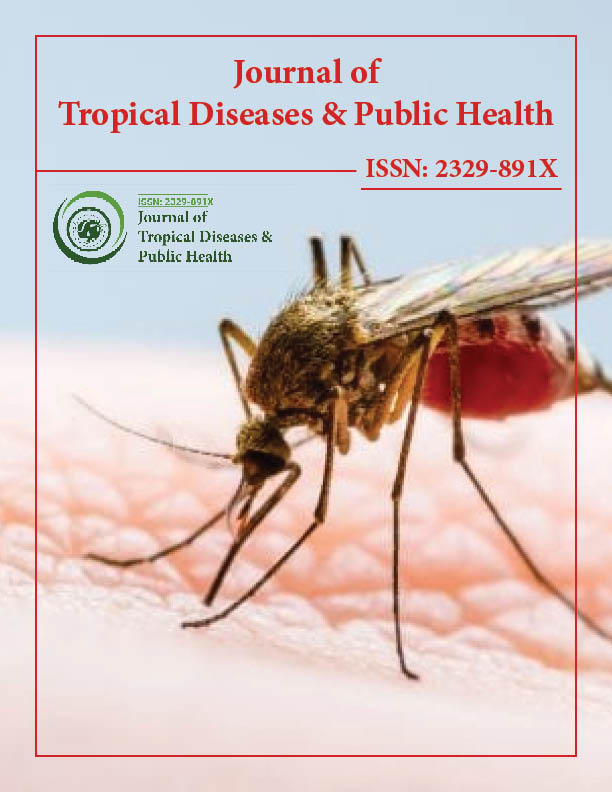Indexed In
- Open J Gate
- Academic Keys
- ResearchBible
- China National Knowledge Infrastructure (CNKI)
- Centre for Agriculture and Biosciences International (CABI)
- RefSeek
- Hamdard University
- EBSCO A-Z
- OCLC- WorldCat
- CABI full text
- Publons
- Geneva Foundation for Medical Education and Research
- Google Scholar
Useful Links
Share This Page
Journal Flyer

Open Access Journals
- Agri and Aquaculture
- Biochemistry
- Bioinformatics & Systems Biology
- Business & Management
- Chemistry
- Clinical Sciences
- Engineering
- Food & Nutrition
- General Science
- Genetics & Molecular Biology
- Immunology & Microbiology
- Medical Sciences
- Neuroscience & Psychology
- Nursing & Health Care
- Pharmaceutical Sciences
Commentary - (2025) Volume 14, Issue 2
Climate Variability and Changing Patterns of Schistosomiasis in Inland Tropical Water Systems
Elias Tsegaye*Received: 26-May-2025, Manuscript No. JTD-25-29795 ; Editor assigned: 28-May-2025, Pre QC No. JTD-25-29795 (PQ); Reviewed: 11-Jun-2025, QC No. JTD-25-29795 ; Revised: 18-Jun-2025, Manuscript No. JTD-25-29795 (R); Published: 25-Jun-2025, DOI: 10.35241/2329-891X.25.13.478
Description
Dengue continues to pose a seasonal burden in many tropical cities, with its patterns of occurrence showing sensitivity to climatic variations. In recent years, the increase in ambient temperatures across urban zones has raised questions regarding its possible relationship with the proliferation of disease-carrying vectors. The rise in dengue infections in high-density neighborhoods, particularly those with limited infrastructure and sanitation services, suggests that environmental and climatic elements should be carefully examined in public health planning.
Studies conducted across major tropical cities such as Manila, Dhaka, and Lagos have drawn attention to the role of heat islands in increasing mosquito activity. In such environments, concrete surfaces, vehicular emissions, and industrial operations collectively contribute to temperature elevations that differ from surrounding rural regions [1-3]. This distinction in local climate has been linked to enhanced breeding behavior of Aedes aegypti, the principal vector of dengue. Unlike other mosquito species, Aedes tends to prefer small, stagnant bodies of clean water found in domestic and peri-domestic containers conditions frequently encountered in households lacking regular water supply or waste management services.
The interaction between temperature and mosquito biology cannot be ignored. Warmer conditions accelerate the mosquito life cycle, from egg to adult, and reduce the incubation period of the virus inside the mosquito. Consequently, mosquitoes become capable of transmitting the virus at a faster rate. This trend leads to increased case counts in peak temperature months, particularly in urban slums where human exposure is difficult to control. In a recent three-year study conducted in southeastern Asia, regions experiencing more than 30 consecutive days of temperatures above 32°C had a corresponding spike in dengue-related hospitalizations by over 40%.
Rainfall also plays a role, though its influence is more complex. While moderate rains can expand breeding habitats, excessive precipitation may wash away larvae [4-8]. Therefore, regions with intermittent but not overwhelming rainfall tend to support higher densities of Aedes mosquitoes. This climatic pattern is typical of equatorial cities where monsoonal rains alternate with dry periods, allowing temporary water storage in open containers to become mosquito breeding hotspots.
Urban infrastructure must also be taken into account. Many rapidly expanding cities lack organized drainage and face issues such as open refuse, uncovered septic tanks, and insufficient stormwater control [9-10]. All these factors combine to create microhabitats ideal for mosquito breeding. Human migration into urban centers also increases exposure due to the sheer density of hosts available for blood meals. In a population-dense slum, a single infected mosquito can bite multiple individuals in a short time frame, facilitating swift outbreaks.
To control this pattern, public health agencies must improve surveillance and environmental management strategies. Temperature and rainfall monitoring should be integrated into early-warning systems for dengue outbreaks. By identifying risk zones using satellite data and localized meteorological inputs, interventions such as larviciding or public clean-up campaigns can be timed more effectively. In Brazil, such predictive models have already been adopted in certain municipalities, allowing vector control units to concentrate resources before transmission escalates.
Conclusion
Community engagement remains a critical part of reducing transmission. Efforts to discourage water contact or promote protective behaviors often meet with limited success unless alternatives are provided. For many households, there are no safe or practical substitutes for bathing, washing, and working in local water sources. In such cases, public health messaging must be accompanied by efforts to improve infrastructure, such as the installation of protected washing stations, the provision of safe water for irrigation, and the development of sanitation facilities that prevent contamination of natural water bodiesCitation: Tsegaye E (2025). Climate Variability and Changing Patterns of Schistosomiasis in Inland Tropical Water Systems. J Trop Dis. 13:478.
Copyright: © 2025 Tsegaye E. This is an open-access article distributed under the terms of the Creative Commons Attribution License, which permits unrestricted use, distribution and reproduction in any medium, provided the original author and source are credited.

